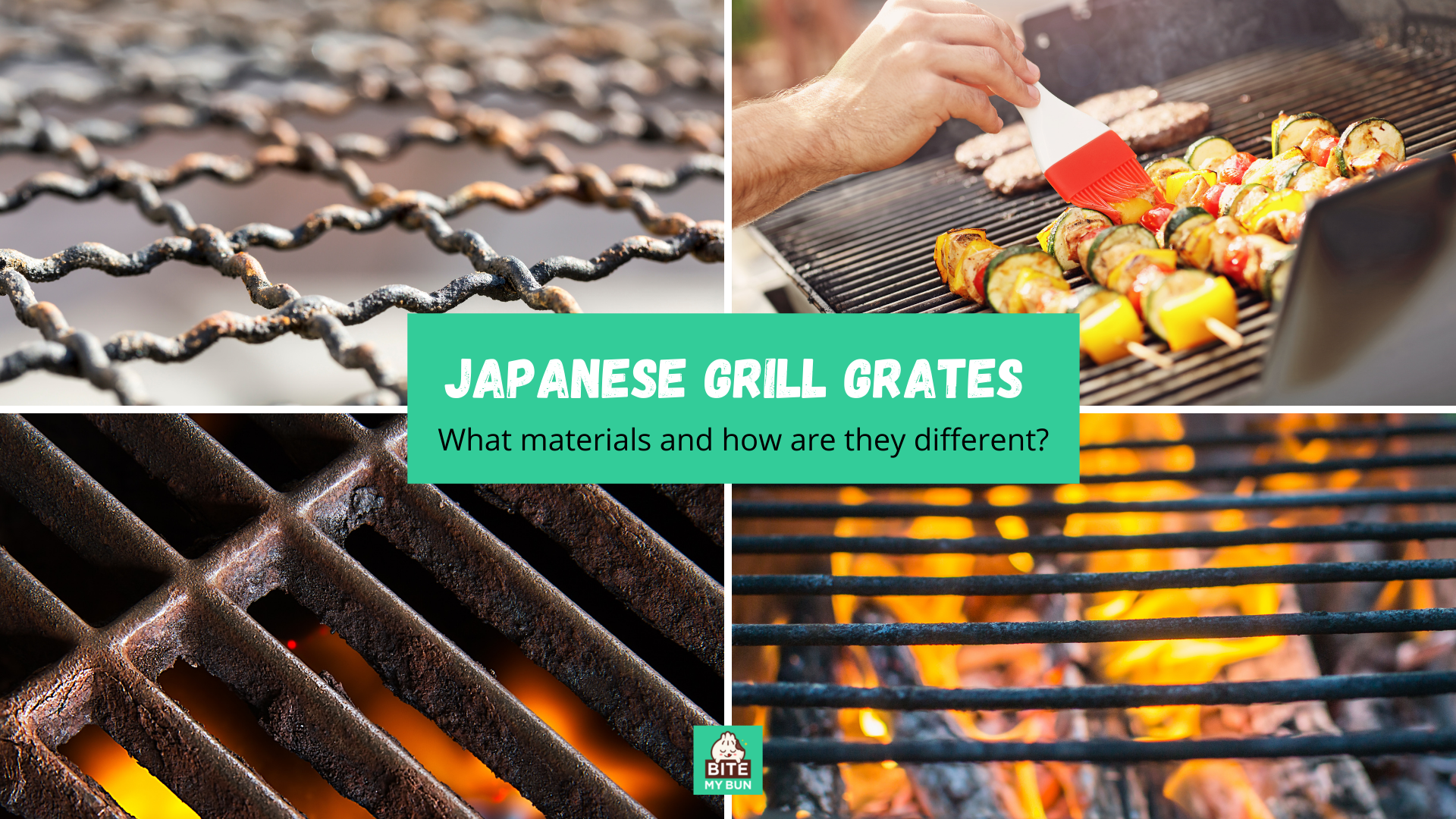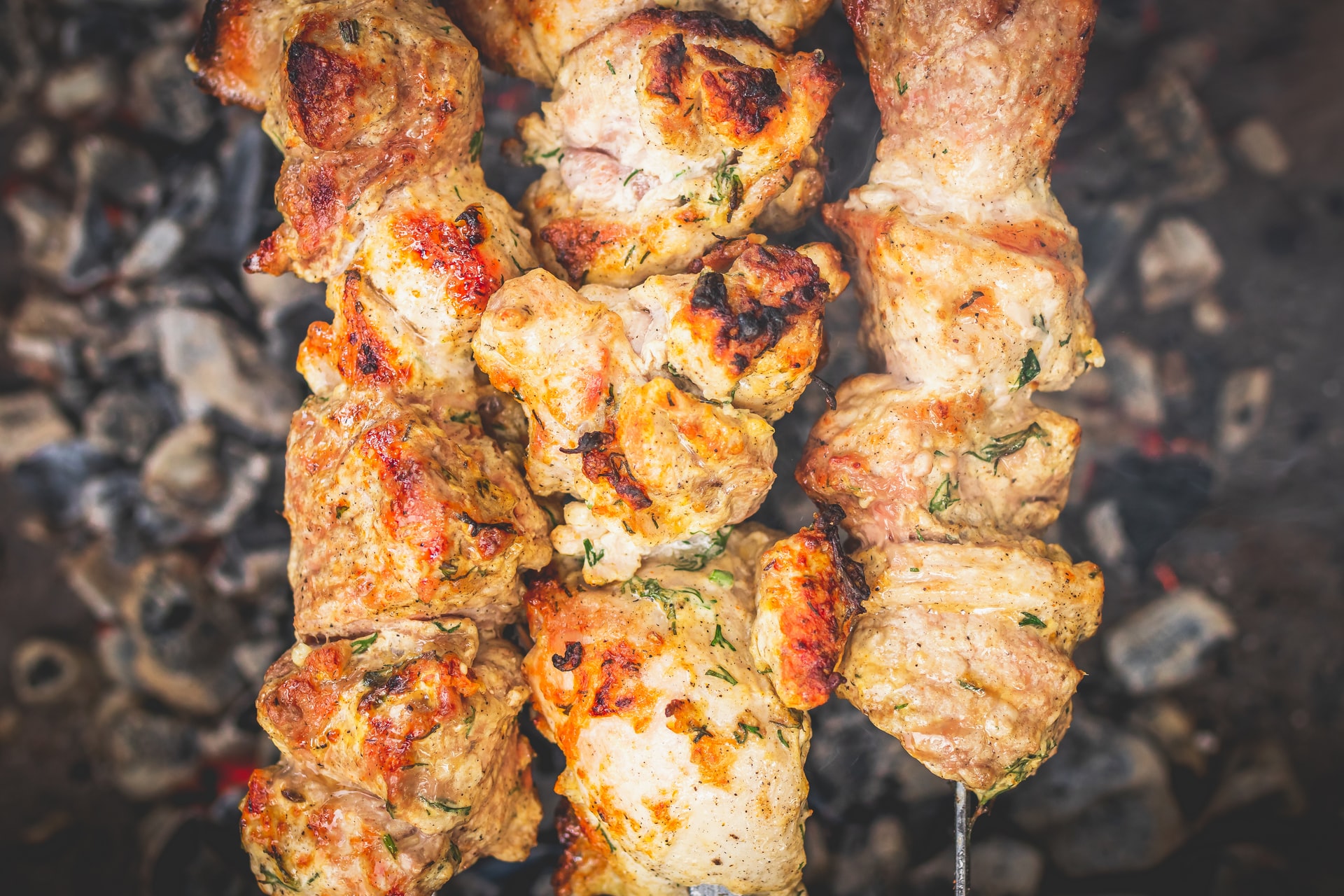Japanese grill grates | What materials and how are they different?
The grill grate is probably the most important component of a grill or cooker. Why? Well, because it comes in direct contact with your food since the food is placed on the grate.
The truth is that not all grates are the same, and there are notable differences between Japanese and Western grill grates. Some materials are better heat distributors than others.

The most popular types of Japanese grills and cookers have open mesh grill grates because these prevent the food from falling through. Usually made of steel or cast-iron, the mesh grills are non-stick and distribute heat evenly, ensuring your food is well-cooked through.
So, what materials are Japanese grill grates made from, and how are they designed?
I will discuss the most common grills and their grates and offer insight into how these grates are different from Western ones.

Check out our new cookbook
Bitemybun's family recipes with complete meal planner and recipe guide.
Try it out for free with Kindle Unlimited:
Read for freeIn this post we'll cover:
Why does the grill grate matter?
People tend to overlook the importance of a good quality grill grate. They think it’s more about the heat source and grill type than the actual grates. But, the grates very important too.
Here’s why:
- The grill grate comes into direct contact with the meat and other foods.
- Grates have a direct effect on how the food cooks and the types of sear marks.
You need to look for grates that provide excellent heat transfer. Also, you want to have a non-stick coating, so the food doesn’t stick.
Finally, a grill grate should be sturdy and durable, so it doesn’t warp from the high temperatures.
Japanese grill mesh/grill net
A mesh grill grate (also called a grill net) is very popular in Japan.
Many types of cookers, like konro grills, have this grill grate, which is quite different from Western cookers, which have heavy-duty thick grill grates.
Usually, these mesh grates are made of chrome steel material.
The grates are very close together and look like a woven metal grate. This design is essential for Japanese grills because it prevents the food from falling through the grates.
This type of design works well for yakitori skewers but also all kinds of other grilled foods. Vegetables that tend to roll around on the grates won’t fall through the mesh.
You can also use a mesh grate to make Korean BBQ and pork belly. Also, it’s great for seafood, especially shrimp and fish.
Read more about the Difference Between Korean BBQ And Japanese BBQ
Types of Japanese grills & their grates
There are many types of Japanese grills. Some are full-on outdoor grills, and some are small tabletop or portable.
These grills have various types of grill grates, and I am sharing that information with you.
The grill grates are usually replaceable. Since the weave is made of thin metals, the heat can warp the grate, so it’s normal to replace them once in a while. After all, the grates are relatively inexpensive.
Hibachi
The hibachi grill is a small round tabletop charcoal grill usually made of porcelain or heatproof ceramic material.
For hibachi, look for cast-iron grill grates because it’s one of the most heavy-duty materials out there.
But, stainless steel mesh grates are popular too because they prevent the food from sticking, and they are easy to clean.
However, the cast-iron grates make the hibachi a durable and heavy-duty grill.
Shichirin
This special grill is traditionally made from diatomaceous earth, a natural clay-like material, or a modern ceramic material.
It’s a small portable and tabletop grill used for cooking smaller food pieces and yakiniku (one of the most well known Japanese BBQs). You can also cook skewered meats and seafood.
You’ll find that the grill grates can be made of cast iron or iron with a zinc plating.
Read more about the Shichirin grill in my review of the top 3 best grills [+Shichirin explained]
Konro
It’s a narrow type of small box-shaped grill that runs on gas or charcoal. Basically, it is also a type of hibachi grill.
It is used for cooking mainly skewered “yaki” foods, although you can cook just about anything. The grates are usually made of welded stainless steel.
Teppanyaki
The teppanyaki is a type of iron grill.
It’s a riddle grill with a smooth, flat iron plate. Instead of the classic grate or mesh grate, teppan-style cooking is all about cooking on top of the flat griddle.
Yakitori – what grates do you need?
A grill for yakitori usually has stainless-steel yakitori grill grates.
Most yakitori grill grates are a mesh. The cooking grates typically have a long rectangular shape which is ideal for making skewers.
Also, the grates are narrower than traditional round or rectangular ones.
The mesh grate really matters depending on the type of food you cook. For example, yakitori is on skewers and needs to be rolled around.
Mesh patterns ensure that the pieces of food don’t fall through the grates. Also, the individual metallic parts in the mesh are very thin.
Japanese people prefer to have woven mesh as the grate over spaced-out patterns.
What about no grates?

There are some special long rectangular yakitori grills that are designed for making yaki only.
These actually have no grates. The long grill has a metal bar running across the firebox horizontally, supporting the metal or bamboo skewers.
Thus, the person cooking can turn the skewers while cooking.
Grill grate materials
The common thing about Western and Japanese grill grates is that they are often made of the same materials.
In fact, the most popular materials used to make grates are stainless steel, cast-iron, enamel-coated steel, and zinc-coated iron. Anodized aluminum is also popular, but more so in Western grills like those made for Weber gas grills.
Sure, there are some different alloys used too, but the previous three are most common.
Let’s take a look at these three materials and what makes each one special. I will talk about the pros and cons of each.
Stainless steel
Pros
- Lightweight grate material – easy to maneuver and access the coals underneath.
- Inexpensive
- Quick to heat up
- Pretty resistant to corrosion, although not quite 100%.
- Easy to clean
- Non-stick
Cons
- Stainless steel is a thin material and doesn’t retain heat as well as cast iron.
- Over time, the surface degrades and becomes rough; thus, it loses the non-stick properties.
Cast iron
Pros
- Very efficient at heat retention
- Food cooks evenly
- Great heat transfer and gives food those classic sear marks
- Very durable if cared for and seasoned
- Food cooks a bit quicker
Cons
- Prone to corrosion and rust, so it needs seasoning.
- Takes longer to heat up compared to stainless steel
- Heavy and hard to clean
Enamel or porcelain coating
Pros
- Used as a coating for stainless steel and iron, but it’s affordable.
- Has a smooth and nonstick surface that doesn’t let the food stick to the grates.
- Prevents the metal from corrosion and rust.
- Very durable
- Improves heat retention for stainless steel.
Cons
- The enamel coating chips off after extensive use.
- Cleaning and high heat make the coating sensitive and prone to degradation.
- Loses nonstick properties.
Anodized aluminum
Pros
- Anodized aluminum is safe for cooking; it doesn’t eliminate toxic particles.
- Better at searing and sizzling meat in its own juices.
- It helps fatty juices stick to the outside of the food and adds flavor.
- Traps and retains heat very well.
- Doesn’t rust easily.
Cons
- Anodized aluminum is hard to clean, so you have to scrub the grates a lot.
- Sometimes it starts to lose the nonstick properties.
- Can warp over time.
Iron with zinc coating
I just want to briefly mention that some grates are made of iron with zinc plating. Known as galvanized iron, it’s not the best for cooking because the zinc residue seeps into the food, and it’s not healthy for the body.
These grates are durable because they are rust and corrosion-proof. However, these coated iron grates are not very popular, so you probably don’t have to worry about them.
Japanese vs Western grill grates
I mentioned before that both Western and Japanese grill grates are usually made of the same materials, especially stainless steel and cast iron. But iron with a zinc coating is also common and just as good.
The main difference is the shape of the grills, which then influences the shape of the grill grates.
Japanese grills are generally much smaller than classic pellet or propane smokers that have lots of cooking space.
The hibachi, for example, has about half or even less cooking space than a classic Western grill. As a result, the grates are smaller and closer together.
Also, the grate patterns are different too because Japanese cookers also have mesh grills. This wire-woven mesh grate ensures food (especially veggies and seafood) doesn’t fall through the grates and burn.
Most Japanese grills have an open-grate design.
Takeaway
The main takeaway is that Japanese and Western grills are quite different in shape and size. Thus, the grill grates are different, too; Japanese grates are usually in an open mesh pattern so that food doesn’t slip between the grates.
If you’re going to be buying special grates for your konro, yakitori, or hibachi grill, look for sturdy stainless steel or cast-iron grates because they will conduct heat better and cook your food evenly.
Now it’s time to start grilling!
Also read my review on the 7 best Binchotan Grills & Binchotan Charcoal for every $ range
Check out our new cookbook
Bitemybun's family recipes with complete meal planner and recipe guide.
Try it out for free with Kindle Unlimited:
Read for freeJoost Nusselder, the founder of Bite My Bun is a content marketer, dad and loves trying out new food with Japanese food at the heart of his passion, and together with his team he's been creating in-depth blog articles since 2016 to help loyal readers with recipes and cooking tips.
